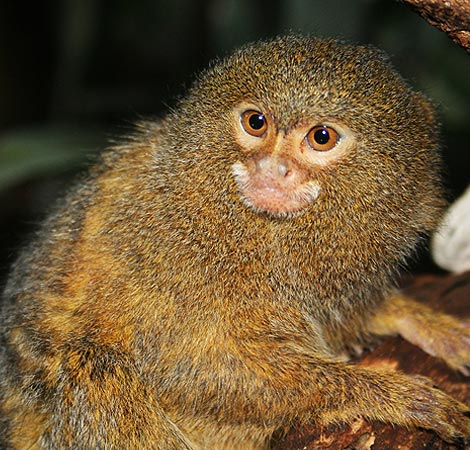Marmoset Pygmy Monkey, The marmoset pygmy monkey, also known as the Cebuella pygmaea, is one of the smallest primates in the world and a fascinating species that continues to capture the hearts of animal lovers and researchers alike. Native to the rainforests of the western Amazon Basin in countries like Brazil, Colombia, Ecuador, Peru, and Bolivia, this miniature monkey stands out due to its tiny size, unique appearance, and agile behavior.
Physical Features
The marmoset pygmy monkey is incredibly small, measuring only about 4 to 6 inches (10 to 15 cm) in body length, excluding its tail, which can be longer than its body. Weighing around 100 grams (3.5 ounces), it is roughly the size of a human thumb. Its fur is a mix of brown, gold, and greenish hues, providing excellent camouflage among the trees. It has a long, banded tail, large eyes, and sharp claws that help it cling to tree bark — a key adaptation for its arboreal lifestyle.
Behavior and Diet
This species is highly social and typically lives in small family groups consisting of 2 to 9 members. The marmoset pygmy monkey communicates through a variety of vocalizations, body language, and even facial expressions. They are extremely territorial and use scent marking to establish boundaries.
The diet of the marmoset pygmy monkey mainly consists of tree sap and gum, which it extracts using specialized lower incisors. It also eats insects, fruits, and small reptiles. Their ability to exploit tree sap as a food source is a remarkable adaptation that sets them apart from many other primates.
Habitat and Conservation
Marmoset pygmy monkeys inhabit the dense, tropical rainforests where they move rapidly and gracefully through the tree canopy. They are most active during the day (diurnal) and are known for their agility and speed.
While the species is not currently classified as endangered, habitat destruction due to logging, agriculture, and human encroachment poses significant threats. Additionally, illegal pet trade has become a growing concern. Keeping a marmoset pygmy monkey as a pet is often discouraged due to ethical concerns and the challenges of meeting their complex needs in captivity.
Importance in Research and Ecology
The marmoset pygmy monkey plays a crucial role in the ecosystem by helping to control insect populations and promoting plant growth through seed dispersal. Furthermore, it is of interest to scientists studying primate behavior, communication, and social dynamics.
Conclusion
The marmoset pygmy monkey is a tiny marvel of nature, blending agility, intelligence, and adaptability. While it may be tempting to admire them as pets due to their size and cuteness, they belong in the wild where they thrive best. Protecting their natural habitat and promoting awareness is key to ensuring that future generations can continue to learn about and admire this unique primate.


